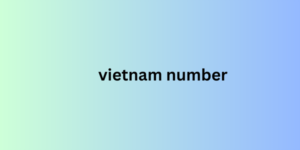Demand factors, also called determinants of demand, are factors that cause demand to change at a constant price level:
Consumer preferences and vietnam number tastes.
Consumer income: As income increases, demand for quality goods increases.
Number of consumers: When there are many consumers, demand is high.
Prices for other products, such as alternatives or complements.

Consumer economic expectations, including those related to inflation or exchange rates.
Non-price competition factors
Non-price supply factors include:
Technological progress.
Economic expectations.
Changes in tax legislation.
Reducing costs through the introduction of modern technologies, upgrading equipment, and so on.
The emergence of new participants in the market.
Changes in prices of goods that may force the organization out of the market.
Natural disasters.
Military and political situation.
Read also!
"How to get contacts from a client: the most effective methods"
Read more
Types of non-price competition
There are several classifications of non-price competition based on the sources of its origin. There are both similarities and differences between them.
In particular, five types of non-price competition can be distinguished:
grocery;
functional;
service;
innovative;
communicative.
Product competition is associated with the expansion of the product range. Companies launch new products, stores increase the number of suppliers whose products are presented in them, which allows them to attract new customers.
Functional competition involves providing additional services in order to expand the scope of activities. For example, a bank branch can install a vending machine for drinks, and a shopping center can organize photocopying.
Service competition is aimed at maximizing customer satisfaction. Thus, you can organize a 24-hour hotline, free delivery, a play area for children in the store, after-sales service. To use this type of competition, you should explain all the details to employees and conduct appropriate training for them.
Training standards
Innovative competition means that the company strives to implement the latest technological solutions in the customer service process faster than its competitors, such as remote service. In the case of stores, this means online ordering of goods with home delivery. Banks can launch a mobile application for remote account management.
Communicative competition is found in retail. Its essence is that the client should have the feeling that he is part of a certain category of people connected by common values. A good example is an organic food store. The goods are more expensive there, but at the same time, customers feel that they are buying something exclusive that not everyone can afford.